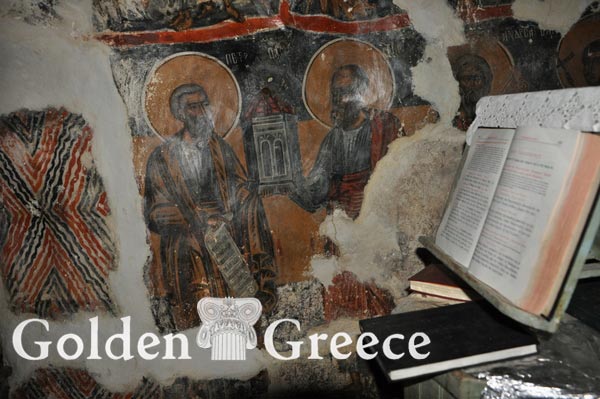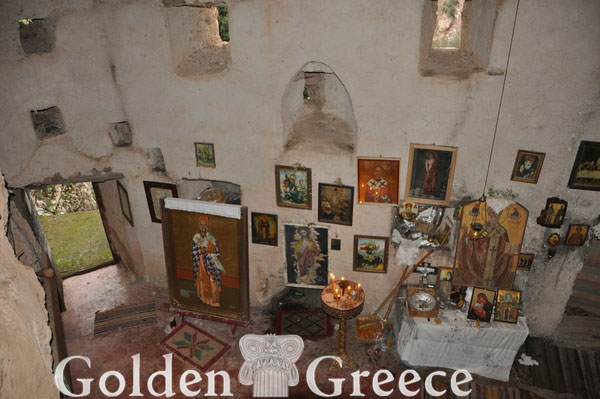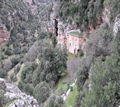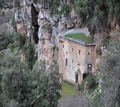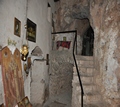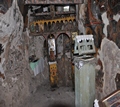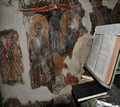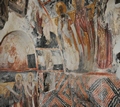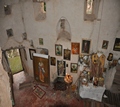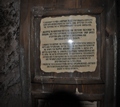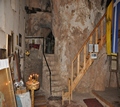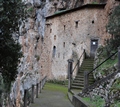
The Monastery of Agios Nikolaos Valtetsinikos, is an old and historic monastery and hermitage located on the western side of the Kapsalis gorge, at a distance of 3 km from Valtetsinikos, on the road to the village of Olomades.
It is built inside the fold of a rock, in a cavernous formation.
Today the monastery is now abandoned.
Also known as the Old Monastery, it is dedicated to Agios Nikolaos and Analipsi. It was built around 1500-1550, a time when people sought refuge in monasticism. Some were burnt in 1826 by Ibrahim. Its official dissolution took place in 1833.
The monastery complex has undergone renovations, during the 21st match, when a series of battlements (which are cone-shaped, internal dimensions 60x70cm and external 12x15cm) and small windows were added. Due to its inaccessible location, it was a fortress and a refuge for fighters and residents. It is a real natural fortress, as it is almost completely covered by a huge cave, inside which most of it is built. A small part of the monastery has an artificial roof and only the facade has been built.
The entrance to the monastery is today by a stone staircase that leads to a small hall, the exonarthex, 23 sq.m. The two temples are built on two levels-floors.
A staircase leads to the upper level where is the temple of Ascension, carved into the rock. The temple preserves, although in a bad state from time, humidity and lack of maintenance, wonderful frescoes from the middle of the 16th century. The sanctuary is separated by a small wooden iconostasis. In a cavity of the rock that has the form of a dome, Pantokrator is depicted with the Evangelists.
Above its entrance is a built-in vase that functioned as a speaker. From the inner narthex a narrow corridor leads to the church of Agios Nikolaos which is located on the lower level. It is a small church that can barely fit the priests and two chanters. The iconography is damaged. Only traces of two hagiographies are preserved.
On the right side of the portico, a wooden staircase leads to a balcony, from where a 50m tunnel. leads out of the monastery complex. This passage was used to communicate the monastery with the buildings outside it. The corridor that leads to the church of Agios Nikolaos continues to an open space, the "outside". Next to it there is a large cave, where in 1826 the villagers had stored their crops.
The monastery is connected to a remarkable episode during the Revolution. In September 1826, hundreds of women and children and a few fighters from Valtesiniko fled there to save themselves from the raid of Ibrahim's army. Headed by Ibrahim himself who invaded the village to avenge the murder of his nephew, Beopoulos, by rebels near Agridaki. The Turks raided the monastery after treachery. The prisoners, however, defended themselves bravely, causing them great losses. In fact, they repelled the attempt of the besiegers to invade through a hole they discovered in the roof of the cave, again after betrayal. Then they managed to isolate with wet burlap the fire set by the Turks, throwing burning wood from the hole in the roof towards the prisoners in the monastery. As a result, a part of the monastery burned down. After three days, however, the Turks lifted the siege due to losses and their desire to withdraw to Patras. And today one still finds burnt wheat ears in the large cave after the terrace. Also, the boulder that the Turks threw from the hole can still be seen, which climbed between the rocks.
The monastery celebrates twice a year, on May 9, Saint Nicholas and the Ascension.
Editor: Fotini Anastasopoulou







